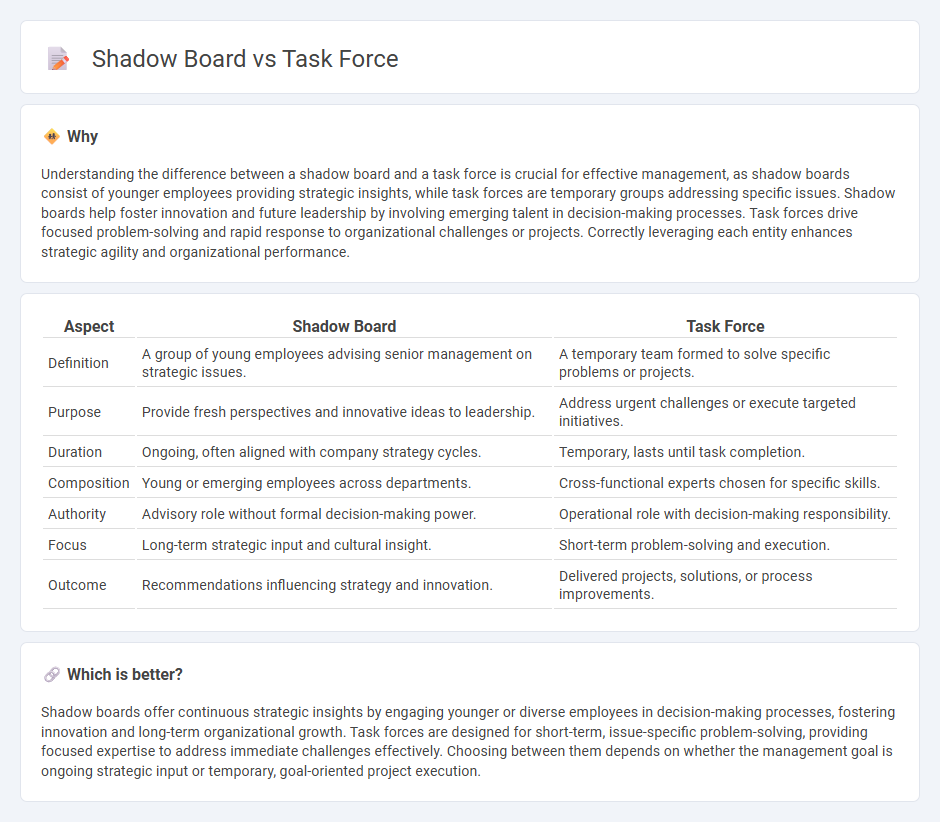
Shadow boards consist of younger employees who provide fresh insights and advise senior management on strategic decisions, promoting innovation and diversity of thought. Task forces are temporary, cross-functional teams created to address specific challenges or projects, ensuring focused problem-solving and rapid execution. Discover how these distinct management tools can enhance organizational agility and decision-making.
Why it is important
Understanding the difference between a shadow board and a task force is crucial for effective management, as shadow boards consist of younger employees providing strategic insights, while task forces are temporary groups addressing specific issues. Shadow boards help foster innovation and future leadership by involving emerging talent in decision-making processes. Task forces drive focused problem-solving and rapid response to organizational challenges or projects. Correctly leveraging each entity enhances strategic agility and organizational performance.
Comparison Table
| Aspect | Shadow Board | Task Force |
|---|---|---|
| Definition | A group of young employees advising senior management on strategic issues. | A temporary team formed to solve specific problems or projects. |
| Purpose | Provide fresh perspectives and innovative ideas to leadership. | Address urgent challenges or execute targeted initiatives. |
| Duration | Ongoing, often aligned with company strategy cycles. | Temporary, lasts until task completion. |
| Composition | Young or emerging employees across departments. | Cross-functional experts chosen for specific skills. |
| Authority | Advisory role without formal decision-making power. | Operational role with decision-making responsibility. |
| Focus | Long-term strategic input and cultural insight. | Short-term problem-solving and execution. |
| Outcome | Recommendations influencing strategy and innovation. | Delivered projects, solutions, or process improvements. |
Which is better?
Shadow boards offer continuous strategic insights by engaging younger or diverse employees in decision-making processes, fostering innovation and long-term organizational growth. Task forces are designed for short-term, issue-specific problem-solving, providing focused expertise to address immediate challenges effectively. Choosing between them depends on whether the management goal is ongoing strategic input or temporary, goal-oriented project execution.
Connection
Shadow boards and task forces both serve as dynamic mechanisms within management to foster innovation and agility. Shadow boards consist of younger or emerging employees providing fresh perspectives to senior leadership, while task forces are temporary groups formed to address specific challenges or projects. Their connection lies in their goal to enhance decision-making and problem-solving by leveraging diverse expertise and focused collaboration.
Key Terms
Temporary Team
A task force is a temporary team assembled to address specific challenges or projects, often cross-functional and time-bound to achieve focused results. Shadow boards consist of emerging leaders who act as advisory groups, offering fresh perspectives without formal decision-making power. Explore how these temporary teams drive innovation and agility within organizations.
Advisory Group
A task force is a temporary team formed to address specific issues or projects, often implementing actionable solutions within a set timeframe. In contrast, a shadow board is an advisory group composed of younger or less-experienced employees who provide insights and feedback to senior executives, focusing on strategic perspectives rather than direct execution. Explore how integrating advisory groups like shadow boards can enhance organizational decision-making and innovation.
Decision-Making
Task forces and shadow boards differ significantly in decision-making roles, with task forces being temporary groups assembled to address specific challenges, executing decisions swiftly based on expert input. Shadow boards consist of emerging leaders who provide strategic advice and alternative perspectives to senior management, influencing decisions indirectly through feedback and recommendations. Explore the distinct impacts of each on organizational governance and innovation.
Source and External Links
Task Force Program | State of California - Department of Justice - The California Department of Justice's Task Force Program collaborates with local agencies to combat major crimes like drug trafficking and gang activity.
Task force - Wikipedia - A task force is a temporary organization formed to solve a specific problem, often found in military, government, and business contexts.
Task Forces - Leadership Conference on Civil Rights - The Leadership Conference on Civil Rights utilizes task forces to advance social and economic justice in areas like education, employment, and voting rights.
 dowidth.com
dowidth.com